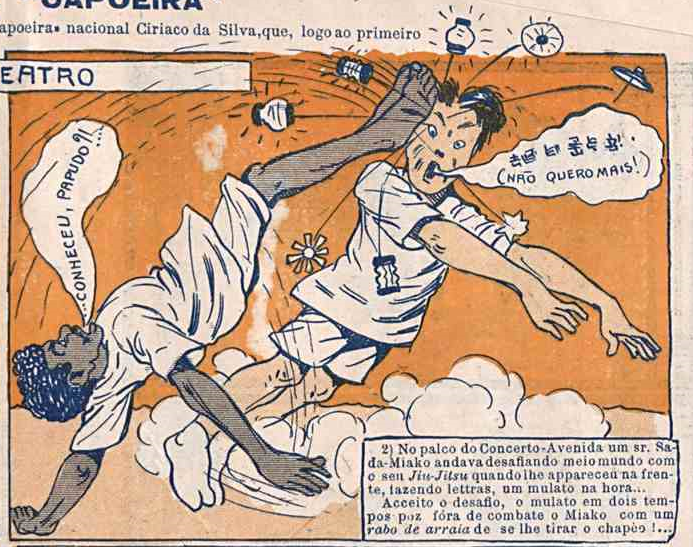
https://www.youtube.com/watch?v=jShp2qJ-BFg
Pantana was one of the acrobatic kicks of the old Capoeira Carioca; and one of its popular finishers.
It must be done with LightLegs; the proper archetype is Snake+LightLegs.

Ciriaco da Silva knocking his Japanese opponent out with a Pantana; on an old caricature.
-
The entry is a bit more acrobatic!
The opponent attacks you, having his right leg forward.
Equip LightLegs and evade by sprawling both your legs backward, your left leg more to the rear. When your toes hit the ground, use the elastic/springy force from the sprawl to throw you upward onto your hands, like a front handspring.
However, the LightLegs modify the movement; so instead of a front handspring, you take a step forward with your right hand.
As you jump, drop both hands onto opponent's feet. This will create a nerve disruption in the opponent, freezing him to the spot.
Then the kick hits with both feet into his head or chest; it is also a high-energy point, so shout "Haaa!" as you kick.
The kick applies a nerve strangle to the opponent; kicks him hard; and throws him on the ground. It also pushes you back onto your feet.
However, if you do it solo, or you miss the opponent, the LightLegs make your body spin rightward; lifting your right hand, overspinning, and landing forward onto your right hand and into a squat.
-
The drill
The above spinning/drilling movement is very important! It is caused by LightLegs and it is not normally seen when the kick hits the target; however, it is essential as this is what gives the kick its power. If you do Pantana without LightLegs - and thus, without the spin - it looks like an unfinished handspring/handstand and it is quite a weak kick.
This is what people usually do today when they try to do a Pantana.
-
To apply the nerve strangle, you must also use the vocalization when kicking.
-
This type of Pantana was used as a counter; with the sprawl entry used to evade opponent's attack.
-
If you pin opponent's feet with your hands, this Pantana will also apply a breath sealer(7sec) when the opponent hits the ground.
Note that if you keep your weight on opponent's feet, the fall might also injure his ankles.
-
If you are like me, you are probably wondering: What if the opponent has his legs spread so you cannot reach his feet with your hands?
In that case, jump directly between his feet, as deep as you can get (rubbing against his body with your body). This has even more pronounced nerve disruption effect; in fact, it applies a nerve strangle, again, nailing him to the spot.
Note that this trick makes or breaks a proper Pantana; because if you do not nail him to the spot by the nerve disruption/strangle jump, he can easily evade the following kick.
-
Proper Pantana thus has three parts:
-the sprawl entry
-jump on opponent's feet - nerve disruptor to nail him to the spot (or jump deep between his legs to do the same)
-the LightLegs spiral finish
Only then is the kick worth something from the combative point of view.
-
Pantana is described by Plácido de Abreu(1886); later by Burlamaqui(1928) and even by Lamartine Costa(1960s) or Nestor capoeira.
Starting with Burlamaqui, the kick is described inadequately or downright wrong; making it a poor version of front handspring - you just do a front handspring and hope it somehow hits the opponent (and even fall down with him!(Costa)) etc.
It is clear that the knowledge about Pantana gradually degraded.
However, real Pantana is a different story! The kick is very devious; in that the moment you put your hands on opponent's feet, it is as if he is already hit! That is because the jump will nail him to the spot with a nerve disruption and thus stop him from evading or even blocking with any effectivity. However, to have that effect, it must be done properly, with LightLegs.
-
Pantana was used by capoeira Cyriaco to defeat his Japanese jujutsu opponent in their famous match (1909).
-
The getup
To get up quickly from the final positon when your Pantana misses, stand on your left toes, lift your right leg and kick it upward and forward; this, done with LightLegs, will pull you up into standing. This is the classic LightLegs getup from Queda de tres evasion (see my article on Carioca evasions).
-
Pantana was also called Rabo de arraia at certain times and places.
-
This is Pantana depicted on a old caricature. Note that it is even shows what happens when the Pantana misses ("Pantana de esquina");the drill and the getup.

Raul Pederneiras “O Nosso Jogo”, 1926.
"Pantana de esquina" is not a type of Pantana (as people sometimes think); instead, it is a Pantana that missed the target, so it performed the LightLegs spin.
(Note that the caricature is of a different type of Pantana, Pantana de Cocoras, which we will also demonstrate later. However, the finish is the same with both Pantanas).
-
In one source, it is written that old capoeiras had an interesting passtime, in which they 'made the church bells ring using their bodies'. From the old capoeiragem techniques I know, the only one that could be used to make the huge bell move and ring is Pantana (and then Voo do morçego, but that would not be as much fun, would it).
So next time you are near a church bell, you can try this game and try to make it ring using Pantana.
-
The above game testifies to the great power of Pantana, as it had to be able to get the massive bell moving. And it is a throwing power; strictly speaking, Pantana is not a kick, but a throwing technique.
This Web Page was Built with PageBreeze Free HTML Editor